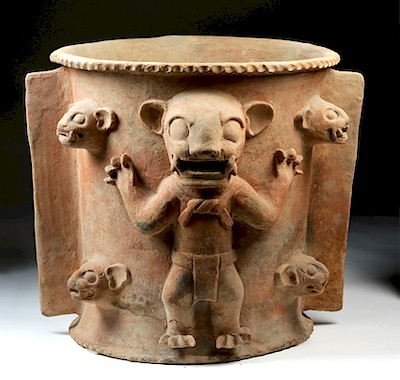17th C. German Engravings by D.Custodis (set of 21)
Lot 205
About Seller
Artemis Fine Arts
686 S Taylor Ave, Ste 106
Louisville, CO 80027
United States
Selling antiquities, ancient and ethnographic art online since 1993, Artemis Gallery specializes in Classical Antiquities (Egyptian, Greek, Roman, Near Eastern), Asian, Pre-Columbian, African / Tribal / Oceanographic art. Our extensive inventory includes pottery, stone, metal, wood, glass and textil...Read more
Estimate:
$3,600 - $5,400
Absentee vs Live bid
Two ways to bid:
- Leave a max absentee bid and the platform will bid on your behalf up to your maximum bid during the live auction.
- Bid live during the auction and your bids will be submitted real-time to the auctioneer.
Bid Increments
| Price | Bid Increment |
|---|---|
| $0 | $25 |
| $300 | $50 |
| $1,000 | $100 |
| $2,000 | $250 |
| $5,000 | $500 |
| $10,000 | $1,000 |
| $20,000 | $2,500 |
| $50,000 | $5,000 |
| $100,000 | $10,000 |
| $200,000 | $20,000 |
About Auction
By Artemis Fine Arts
Dec 6, 2018
Set Reminder
2018-12-06 10:00:00
2018-12-06 10:00:00
America/New_York
Bidsquare
Bidsquare : DAY 2 : Pre-Columbian, Ethnographic & Fine Art
https://www.bidsquare.com/auctions/artemis-gallery/day-2-pre-columbian-ethnographic-fine-art-3699
Day 2 of an important 2-dy auction featuring ancient and ethnographic art from around the world. Today's sale will feature Pre-Columbian, Native American, African / Tribal, Ethnographic, Spanish Colonial, Fine Art, much more. Artemis Fine Arts info@artemisgallery.com
Day 2 of an important 2-dy auction featuring ancient and ethnographic art from around the world. Today's sale will feature Pre-Columbian, Native American, African / Tribal, Ethnographic, Spanish Colonial, Fine Art, much more. Artemis Fine Arts info@artemisgallery.com
- Lot Description
Europe, Germany, David Custodis after G. B. Fontana, ca. 1606 CE. Twenty one early Baroque period engravings, broadsheets recognized as "the finest ancient illustrations of armor in existence" by David Custodis (active in the early 1600s), the son of Dominicus Custos (1560-1612) who was an engraver from Augsburg, Germany. These depictions first appeared in Jacob Schrenck von Notzing (1539-1614) Der Aller Durchleuchtigsten und Grossmächtigen Kayser... Köningen und Ertzhertzogen. Fürststen warhafftige Bildnussen. und kurtze Beschreibungen Translated from Latin by Johann Engelbert Noyse von Campenhouten. Innsbruck: Daniel Baur, [1603]. A 1st edition of this manuscript recently sold at Christie's, New York for $10,000. (See http://www.christies.com/lotfinder/books-manuscripts/schrenck-von-notzing-jacob-der-5698585-details.aspx for listing.)
Each engraving features a full-length portrait of an emperor, king, noble, or general depicted in full armor, standing within an arched alcove that is framed by ornamental columns with iconography that specifically applies to the nobleman represented. At the bottom center, each cartouche is inscribed with the subject's name written in ink. On the verso is a full-page narration of the subject represented in Latin. This text is framed within an elaborate design surrounded by a woodcut border showing trophies of war. According to the Christie's cataloguer, these impressive engraved plates depict "a remarkable collection of armor, belonging to military leaders, collected by the Archduke Ferdinand of Tyrol at Castle Ambrass near Innsbruck. The collection was transferred to Vienna in 1796 and placed in the Belvedere in 1806. Today the collection is part of the Museum of Art History in Vienna, which exhibits parts of the collection again at Castle Ambrass."
The subjects depicted in this collection include Carolus Borbonius (plate 22), Philippus Landtgravius Hafsia (plate 25), Gulielmus Julia, Clivia, & Montium Dux (plate 26), Annas Momorancius (plate 28), Robertus Sanfeverinus (plate 32), Maximilianus Archidux Austria (plate 47), Nicolaus Radzivil (plate 49), Camillus Urfinus (plate 58), Aliprandus Madrutius Baro Brentoni e Avi (plate 60), Johannes Ranzovius (plate 66), Augustus Barbadicus Venetus (plate 67), Jacobus Superantius Venetus (plate 69), Cornelius Bentivolius (plate 70), Alcanius Corneus (plate 71), Lazarus Schuendius Baro a HohenLandsperg (plate 74), Johannes Ferenberger ab Avv. (plate 76), Johannes Zamoiski Magnus Cancellarius Polonia (plate 77), Henricus Ranzovius (plate 78), Fernandus Comes Nogarolius (plate 81), Udalricus Tertius Wirtenberga Dux, and Fridericus III Feltrius Urbini Dux. Size: each image measures approximately 16.75" L x 11.25" W (42.5 cm x 28.6 cm); paper measures ~ 18.5" L x 12.5" W (47 x 31.8 cm)
Note: The Christie's listing refers to the engraver of these works as Dominicus Custodis; however, according to my research, the artist was named David Custodis (active in early 1600s) who was son of Dominicus Custos (1560-1612). His father was the son of Pieter Balten as well as an engraver and draftsman from Antwerp who settled in Augsburg and became the second husband of Bartholomeus Killian's widow (1548-1588). Among Custos' claims to fame, he worked for the Emperor Rudolphe II in Prague. Hence, Custodis' familial roots go back to the Antwerp School where Mannerism blossomed.
Provenance: Ex-private Dr. Joseph & Edith Chess collection, Larchmont, NY
All items legal to buy/sell under U.S. Statute covering cultural patrimony Code 2600, CHAPTER 14, and are guaranteed to be as described or your money back.
A Certificate of Authenticity will accompany all winning bids.
We ship worldwide and handle all shipping in-house for your convenience.
#113826Small wormholes on a few that do not obscure the images. Expected wear, a few with staining and tears to peripheries. Overall very good.Condition
- Shipping Info
-
All shipping is handled in-house for your convenience. Your invoice from Artemis Gallery will include shipping calculation instructions. If in doubt, please inquire BEFORE bidding for estimated shipping costs for individual items.
-
- Buyer's Premium



 EUR
EUR CAD
CAD AUD
AUD GBP
GBP MXN
MXN HKD
HKD CNY
CNY MYR
MYR SEK
SEK SGD
SGD CHF
CHF THB
THB




















